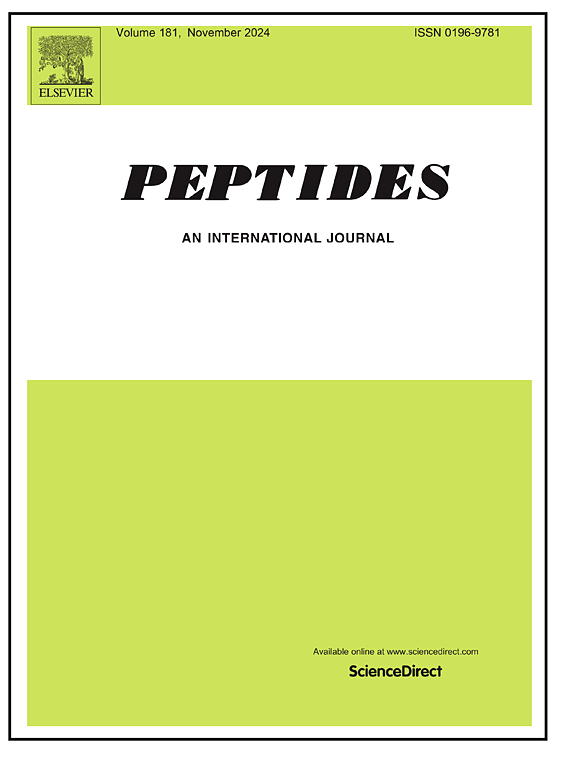Spexin expression in the human bile duct and perihilar cholangiocarcinoma
IF 2.9
4区 医学
Q3 BIOCHEMISTRY & MOLECULAR BIOLOGY
引用次数: 0
Abstract
The bile duct transports bile fluid from the liver to the gallbladder and small intestine. It contains bioactive peptides, including galanin (GAL) and its receptors (GAL1–3-R). Spexin (SPX), a member of the GAL peptide family, activates GAL2-R and GAL3-R. Its expression in perihilar bile ducts or in perihilar cholangiocarcinoma (pCCA), the most common biliary cancer, is largely unknown. This study investigated SPX expression in healthy, cholestatic, and malignant bile duct tissues. Immunohistochemistry was used to evaluate SPX in healthy (n = 4), peritumoral (PIT) (n = 23) and pCCA (n = 34) tissues. Score values of SPX expression were calculated and statistically analyzed. In healthy and PIT tissues with or without cholestasis, SPX expression was predominantly observed in cholangiocytes and nerve fibers. In pCCA, tumor cells also expressed SPX. SPX levels were similar across healthy, peritumoral, and cholangiocytes/tumor cells. In a small pCCA patient cohort (n = 19), SPX expression did not correlate with tumor grade or patient survival (p = 0.0838). The substantial expression of SPX in cholangiocytes and nerve fibers in the bile duct indicates that SPX contributes via galaninergic signaling to gall bladder function. The presence of SPX in submucosal nerve fibers suggests a neuromodulatory role, possibly involving bile duct motility. SPX expression did not correlate with survival in pCCA, whereas previous findings on GAL suggest a prognostic value. This highlights the need for joint studies of SPX and GAL in larger cohorts.
Spexin在人胆管和肝门周围胆管癌中的表达。
胆管将胆汁液从肝脏输送到胆囊和小肠。它含有生物活性肽,包括丙氨酸(GAL)及其受体(GAL1-3-R)。SPX是GAL肽家族的一员,可激活GAL2-R和GAL3-R。它在肝门周围胆管或肝门周围胆管癌(最常见的胆道癌)中的表达在很大程度上是未知的。本研究探讨了SPX在健康、胆汁淤积和恶性胆管组织中的表达。采用免疫组织化学方法评估健康(n = 4)、瘤周(n = 23)和pCCA (n = 34)组织中的SPX。计算SPX表达的评分值并进行统计学分析。在有或没有胆汁淤积的健康和PIT组织中,SPX主要在胆管细胞和神经纤维中表达。在pCCA中,肿瘤细胞也表达SPX。SPX水平在健康细胞、肿瘤周围细胞和胆管细胞/肿瘤细胞中相似。在一个小的pCCA患者队列中(n = 19), SPX表达与肿瘤分级或患者生存无关(p = 0.0838)。SPX在胆管细胞和神经纤维中的大量表达表明SPX通过半乳糖能信号传导参与胆囊功能。粘膜下神经纤维中SPX的存在提示其具有神经调节作用,可能与胆管运动有关。SPX的表达与pCCA患者的生存无关,而先前关于GAL的研究结果表明其具有预后价值。这突出了在更大的队列中对SPX和GAL进行联合研究的必要性。
本文章由计算机程序翻译,如有差异,请以英文原文为准。
求助全文
约1分钟内获得全文
求助全文
来源期刊

Peptides
医学-生化与分子生物学
CiteScore
6.40
自引率
6.70%
发文量
130
审稿时长
28 days
期刊介绍:
Peptides is an international journal presenting original contributions on the biochemistry, physiology and pharmacology of biological active peptides, as well as their functions that relate to gastroenterology, endocrinology, and behavioral effects.
Peptides emphasizes all aspects of high profile peptide research in mammals and non-mammalian vertebrates. Special consideration can be given to plants and invertebrates. Submission of articles with clinical relevance is particularly encouraged.
 求助内容:
求助内容: 应助结果提醒方式:
应助结果提醒方式:


